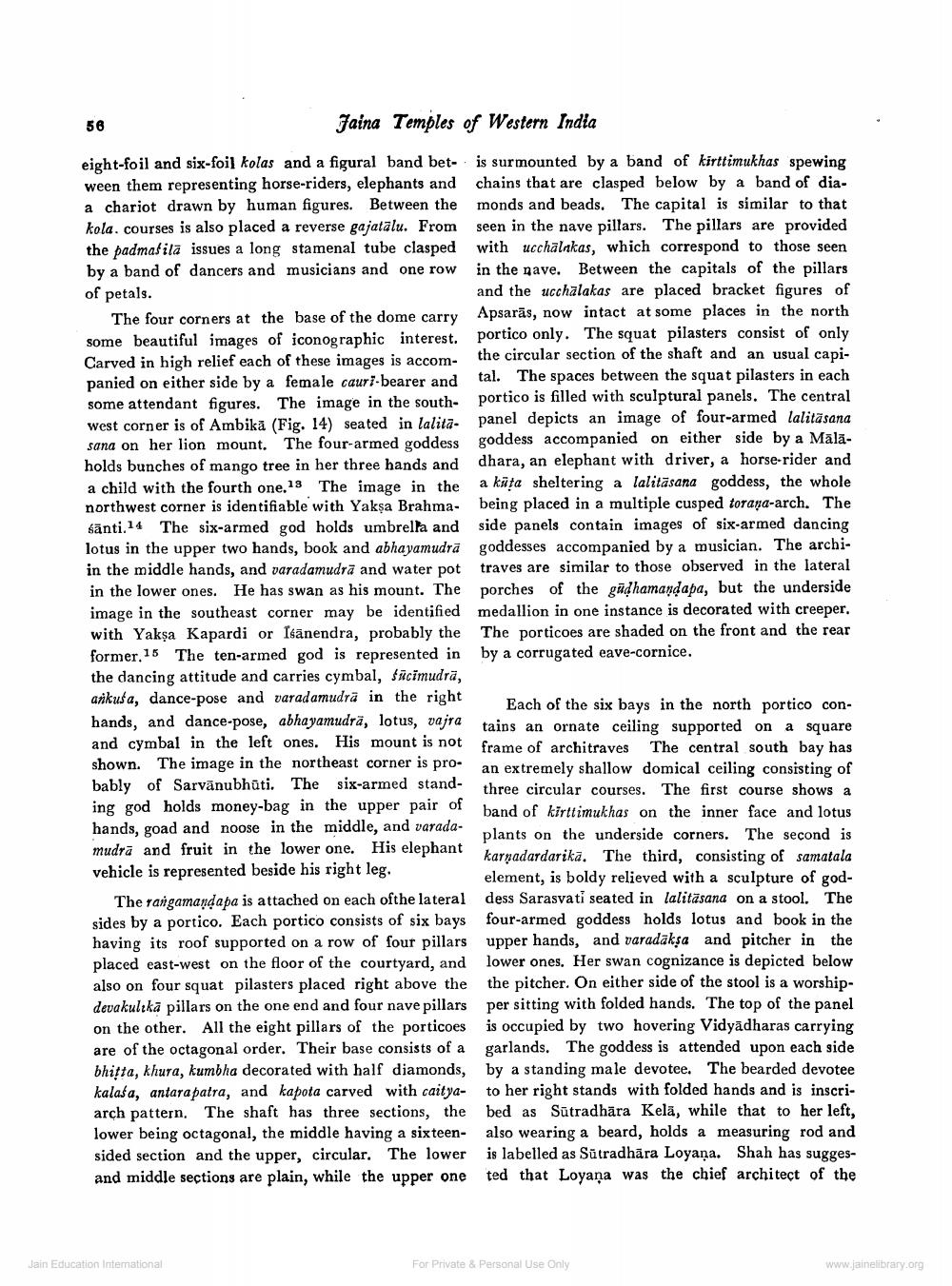________________
56
Faina Temples of Western India
eight-foil and six-foil kolas and a figural band bet- is surmounted by a band of kirttimukhas spewing ween them representing horse-riders, elephants and chains that are clasped below by a band of diaa chariot drawn by human figures. Between the monds and beads. The capital is similar to that kola. courses is also placed a reverse gajatālu. From seen in the nave pillars. The pillars are provided the badmašila issues a long stamenal tube clasped with ucсhälakas, which correspond to those seen by a band of dancers and musicians and one row in the nave. Between the capitals of the pillars of petals.
and the ucchalakas are placed bracket figures of The four corners at the base of the dome carry Apsarās, now intact at some places in the north some beautiful images of iconographic interest. portico only. The squat pilasters consist of only Carved in high relief each of these images is accom
the circular section of the shaft and an usual capipanied on either side by a female cauri-bearer and tal. The spaces between the squat pilasters in each some attendant figures. The image in the south- portico is filled with sculptural panels. The central west corner is of Ambikā (Fig. 14) seated in lalita. panel depicts an image of four-armed lalitasana sana on her lion mount. The four-armed goddess goddess accompanied on either side by a Mālā. holds bunches of mango tree in her three hands and dhara, an elephant with driver, a horse-rider and a child with the fourth one.13 The image in the a kāta sheltering a lalitasana goddess, the whole northwest corner is identifiable with Yakşa Brahma being placed in a multiple cusped torana-arch. The sānti.14 The six-armed god holds umbrella and side panels contain images of six-armed dancing lotus in the upper two hands, book and abhayamudrā goddesses accompanied by a musician. The archiin the middle hands, and varadamudra and water pot traves are similar to those observed in the lateral in the lower ones. He has swan as his mount. The porches of the gūdhamaydapa, but the underside image in the southeast corner may be identified medallion in one instance is decorated with creeper, with Yakşa Kapardi or Isänendra, probably the The porticoes are shaded on the front and the rear former. 15 The ten-armed god is represented in by a corrugated eave-cornice. the dancing attitude and carries cymbal, facimudrā, ankuša, dance-pose and varadamudra in the right Each of the six bays in the north portico conhands, and dance-pose, abhayamudra, lotus, vajra tains an ornate ceiling supported on a square and cymbal in the left ones. His mount is not frame of architraves The central south bay has shown. The image in the northeast corner is pro- an extremely shallow domical ceiling consisting of bably of Sarvānubhūti. The six-armed stand-
three circular courses. three ci
The first course shows a ing god holds money-bag in the upper pair of
band of kirttimukhas on the inner face and lotus hands, goad and noose in the middle, and varada
plants on the underside corners. The second is mudrā and fruit in the lower one. His elephant
karnadardarika. The third, consisting of samatala vehicle is represented beside his right leg.
element, is boldy relieved with a sculpture of godThe rangamandaba is attached on each ofthe lateral dess Sarasvati seated in lalitäsana on a stool. The sides by a portico. Each portico consists of six bays four-armed goddess holds lotus and book in the having its roof supported on a row of four pillars upper hands, and varadaksa and pitcher in the placed east-west on the floor of the courtyard, and lower ones. Her swan cognizance is depicted below also on four squat pilasters placed right above the the pitcher. On either side of the stool is a worshipdevakul kā pillars on the one end and four nave pillars per sitting with folded hands. The top of the panel on the other. All the eight pillars of the porticoes is occupied by two hovering Vidyādharas carrying are of the octagonal order. Their base consists of a garlands. The goddess is attended upon each side bhitta, khura, kumbha decorated with half diamonds, by a standing male devotee. The bearded devotee kalaša, antarapatra, and kapota carved with caitya- to her right stands with folded hands and is inscriarch pattern. The shaft has three sections, the bed as Sūtradhāra Kelā, while that to her left, lower being octagonal, the middle having a sixteen- also wearing a beard, holds a measuring rod and sided section and the upper, circular. The lower is labelled as Sūtradhāra Loyaņa. Shah has suggesand middle sections are plain, while the upper one ted that Loyana was the chief architect of the
Jain Education Interational
For Private & Personal Use Only
www.jainelibrary.org




